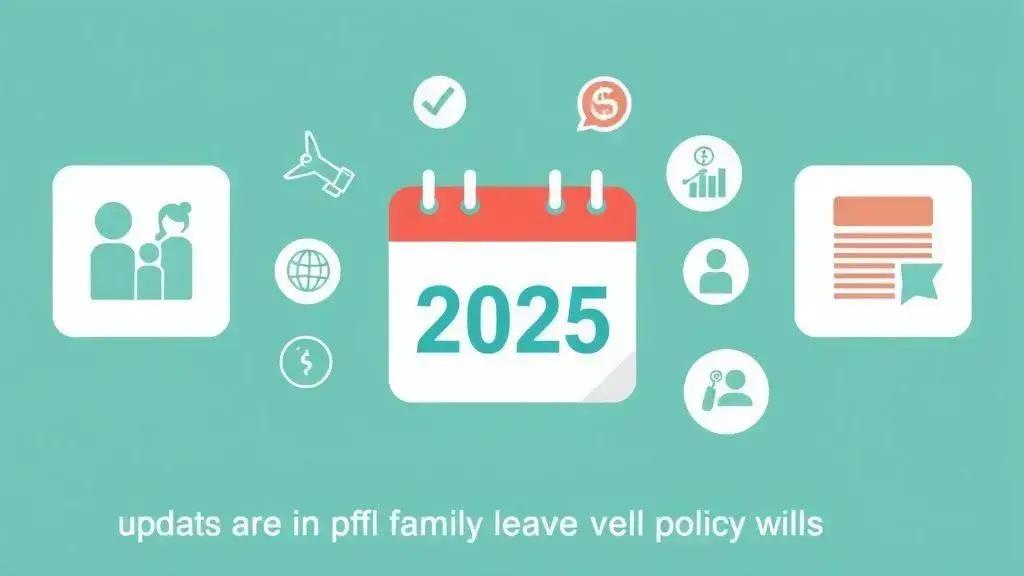Paid family leave policies 2025: What to expect

Paid family leave policies provide employees with paid time off to care for family members or bond with new children, ensuring financial security and emotional well-being during critical life events.
Paid family leave policies 2025 are just around the corner, and they promise to make a significant impact on families. Have you ever wondered how these changes might affect your work-life balance? Let’s dive into the exciting updates ahead!
Understanding paid family leave policies
Understanding paid family leave policies can seem confusing at first, but it’s essential for families planning for the future. These policies allow employees to take time off to care for their loved ones while still receiving pay. Let’s take a closer look.
What are paid family leave policies?
Paid family leave policies refer to the regulations that enable employees to take paid time off for specific family-related reasons. This may include caring for a newborn, adopting a child, or looking after a sick family member. These policies aim to offer financial security during challenging times, so families do not have to choose between their work and their loved ones.
Key components
- Eligibility criteria: Not everyone qualifies for paid family leave. Most states have specific requirements for employees.
- Duration of leave: Leave duration can vary significantly, with some policies offering several weeks while others may extend up to a year.
- Pay rates: It’s vital to understand how much of your salary you’ll receive while on leave, as this can impact your family’s budget.
As we explore further, it’s important to note that each state can have different rules regarding paid family leave policies. While some states offer comprehensive coverage, others may provide minimal support. This variability means that staying informed about the laws in your region is crucial.
Another critical aspect of these policies is the encouragement of work-life balance. Many companies are beginning to recognize that offering paid family leave can improve employee satisfaction and retention. By supporting employees during significant life events, businesses can foster a more loyal and productive workforce.
Potential challenges
While paid family leave policies provide many benefits, they can also present challenges. Some employees may fear job loss when taking leave, despite protections in place. Additionally, navigating benefits and applications may feel overwhelming. Understanding your rights and responsibilities can help ease these concerns.
Key updates for 2025

Key updates for paid family leave policies 2025 promise to enhance the support provided to families. As these policies evolve, it’s important to stay informed about the changes that may affect you.
Expansion of coverage
One major update is the expansion of coverage. Many states are increasing eligibility, allowing more employees access to paid family leave. This means that more families will have the opportunity to take time off when they need it most.
- New qualifying events: Policies are adding more reasons to take leave, including medical emergencies.
- Wider eligibility: Part-time workers and gig economy employees may soon qualify for benefits.
- Extended family benefits: Care for extended family members is becoming a more common category.
In addition to increased coverage, benefits will also see changes that enhance family support. For example, many states are raising the pay rate during the leave. Employees can expect a larger percentage of their salary to be covered, easing financial stress during these important times.
New application processes
Along with changes in coverage and pay, updates to the application process are also in the works. Simplified procedures will make it easier for families to navigate the system and access benefits with less hassle. Each state is working on creating clearer, more user-friendly platforms for submitting applications.
These shifts represent a positive trend toward more inclusive and supportive paid family leave policies. Employers are encouraged to participate in these updates, promoting a culture of care and understanding in the workplace. As new laws roll out, companies that embrace these policies will likely see improvements in employee morale and retention.
Understanding these key updates for 2025 is essential for families planning for future needs. This is a great time to start discussing how these changes may impact your family and workplace.
Benefits of paid family leave
The benefits of paid family leave are profound for both employees and their families. These policies support individuals during critical life events, allowing them to focus on what matters most.
Emotional well-being
Having paid family leave can greatly enhance emotional well-being. Families facing significant changes experience less stress knowing they can take time off without financial worry. This support makes it easier for parents to bond with newborns or care for sick family members.
- Reduced stress levels for employees.
- Improved family relationships during crucial moments.
- Increase in overall happiness and job satisfaction.
Additionally, employees who feel supported are more likely to return to work with renewed focus and energy. The result is a positive cycle for both workers and employers.
Financial security
Another key advantage is financial security. Many families struggle to manage expenses during periods of unpaid leave. The inclusion of paid family leave allows families to maintain their income, covering bills and essential needs without the fear of falling behind.
This aspect is especially important in today’s economy, where living expenses can be high. Access to paid family leave means that parents can prioritize their family’s health and needs without sacrificing their financial status.
Moreover, businesses that offer these benefits often see a return on investment. By providing paid family leave, companies can reduce turnover rates, lower recruitment costs, and build a more loyal workforce.
Positive workplace culture
Implementing paid family leave can create a culture of care within a workplace. Employees are likely to feel valued when they have access to these important benefits. A supportive environment encourages teamwork and motivates employees to perform at their best.
Ultimately, the benefits of paid family leave extend beyond individual families. They contribute to healthier workplaces and communities, fostering a society where family values are prioritized.
Navigating the application process

Navigating the application process for paid family leave can be challenging, but understanding the steps is key to a successful experience. Knowing what to expect helps employees feel more prepared and confident.
Gather necessary documentation
The first step in the application process is gathering all required documentation. You may need to provide proof of your relationship to the family member you’ll be caring for, including birth certificates or medical records. Keeping organized records ensures that you can complete the application smoothly.
- Verify eligibility: Double-check the eligibility criteria for your state.
- Collect personal information: Have your employment records and tax documents ready.
- Prepare any necessary medical documentation: This may include notes from doctors or hospital discharge papers.
In addition to gathering documentation, it is helpful to understand the specific forms needed for your application. Each state may have different requirements, so reviewing this information in advance can save time and reduce stress.
Complete the application
Filling out the application requires careful attention. Be sure to fill out all sections accurately. Providing clear and precise information about your situation will speed up the process.
It’s important to recheck your application before submitting it. A common issue for applicants is missing information or submitting the wrong forms, which can delay approval. If needed, seek assistance from a human resources representative or family leave specialist.
Follow up on your application
After submitting your application, don’t forget to follow up. Many states provide confirmation once your application has been received, but be proactive in checking the status as well. This can help address any potential issues swiftly, ensuring that your paid family leave benefits become available when you need them.
Remember, being well-informed about the application process can make a world of difference. Knowing your rights and the required steps will lead to a more successful navigation of the paid family leave system.
Navigating paid family leave policies is essential for families planning for important life events. With the key updates for 2025, employees can expect better support, including expanded coverage and financial security. Understanding how to apply for these benefits is crucial. By knowing what documents to gather and how to complete the application process, families can ensure they receive the assistance they need. Ultimately, these policies not only benefit employees but also foster a supportive workplace culture that values family and well-being.
FAQ – Frequently Asked Questions about Paid Family Leave Policies
What is paid family leave?
Paid family leave allows employees to take time off to care for a family member or bond with a new child while still receiving pay.
Who is eligible for paid family leave benefits?
Eligibility varies by state, but typically includes full-time and part-time employees who meet specific criteria.
How do I apply for paid family leave?
To apply, gather necessary documentation, complete the required forms, and submit your application to your employer or the state agency.
What are the benefits of paid family leave for employees?
Benefits include financial security during critical times, improved emotional well-being, and a supportive workplace culture.





